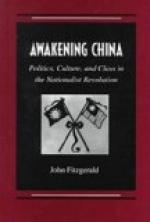It was in Canton that American trade suffered most from the boycott of 1905, because there the ill-treatment of Chinese in America was most deeply felt, the Chinese in California being almost exclusively from the province of Canton.
The viceroy of Canton has also the province of Kwangsi under his jurisdiction. Mountainous and thinly peopled, it is regarded by its associate as a burden, being in an almost chronic state of rebellion and requiring large armies to keep its turbulent inhabitants in order.
[Page 14] chapter III
PROVINCE OF FUKIEN
Amoy—Bold Navigators—Foochow—Mountain of Kushan—The Bridge of Ten Thousand Years
Following the coast to the north some three hundred miles we come to Amoy, the first important seaport in the adjacent province of Fukien. The aspect of the country has undergone a change. Hills attain the altitude of mountains, and the alluvial plains, so conspicuous about Canton, become contracted to narrow valleys.
The people, too, are changed in speech and feature. Taller, coarser in physiognomy, with high cheek-bones and harsh voices, their dialect is totally unintelligible to people of the neighbouring province. As an example of the diversity of dialects in China, may be cited the Chinese word for man. In some parts of Fukien it is long; in Canton, yan or yin; at Ningpo, ning; and at Peking, jin.
One is left in doubt whether the people or the mountains which they inhabit were the most prominent factors in determining the dividing line that separates them from their neighbours on the south and west. In enterprise and energy they rival the Cantonese. They are bold navigators; the grand island of Formosa, now ceded to Japan, was colonised by them; and by [Page 15] them also the savage aborigines were driven over to the east coast. A peculiar sort of black tea is grown on these mountains, and, along with grass cloth, forms a staple in the trade of Amoy. The harbour is not wanting in beauty; and a view from one of the hill-tops, from which hundreds of villages are visible, is highly picturesque. Of the town of Amoy with its 200,000 people there is not much to be said except that several missions, British and American, which opened stations there soon after the first war with Great Britain, have met with encouraging success. At Swatow, a district in Canton Province beyond the boundary, the American Baptists have a flourishing mission.
Entering the Formosan Channel we proceed to the mouth of the Min, a fine river which leads up to Foochow (Fuchau), some thirty miles inland. We do not stop to explore the Island of Formosa because, having been ceded to Japan, it no longer forms a part of the Chinese Empire. From the river the whole province is sometimes described as “the country of Min”; but its official name is Fukien. This name does not signify “happily established,” as stated in most books, but is compounded of the names of its two chief cities by taking the first syllable of each, somewhat as the pioneer settlers of Arkansas formed the name of the boundary town of Texarkana. The names of some other provinces of China are formed in the same way; e.g. Kiangsu, Kansuh, and that of the viceregal district of Yuenkwei.




